PROJ6000 - Principles of Project Management Report Analysis
VerifiedAdded on 2022/08/01
|9
|1988
|23
Report
AI Summary
This report delves into the realm of project management, specifically focusing on its impact within manufacturing projects. It commences with an introduction to project management, emphasizing its role in achieving goals within specified constraints, and highlights the importance of adhering to the Project Management Body of Knowledge (PMBOK) and ethical guidelines. The discussion section examines manufacturing management, its processes, and its significance in achieving organizational objectives, including profitability and customer satisfaction. The report then explores the PMBOK and the Project Management Institute's (PMI) code of ethics, emphasizing their roles in standardizing practices and guiding ethical conduct. It identifies key project team members and their contributions to successful project execution, covering essential skills in scope, time, cost, and quality management. The report further explores the impact of project management on controlling, attempting, and improving project deliverables. It compares and contrasts Agile and Waterfall methodologies, discussing their applications, strengths, and weaknesses. Risk management is presented as a critical process, with an emphasis on identifying, analyzing, and responding to potential risks. The report highlights various tools and techniques used in risk management, such as brainstorming, risk data quality assessment, and root cause analysis. Finally, the conclusion summarizes the importance of project management, adherence to ethical guidelines, and the need for continuous improvement in manufacturing management. References are provided to support the analysis.
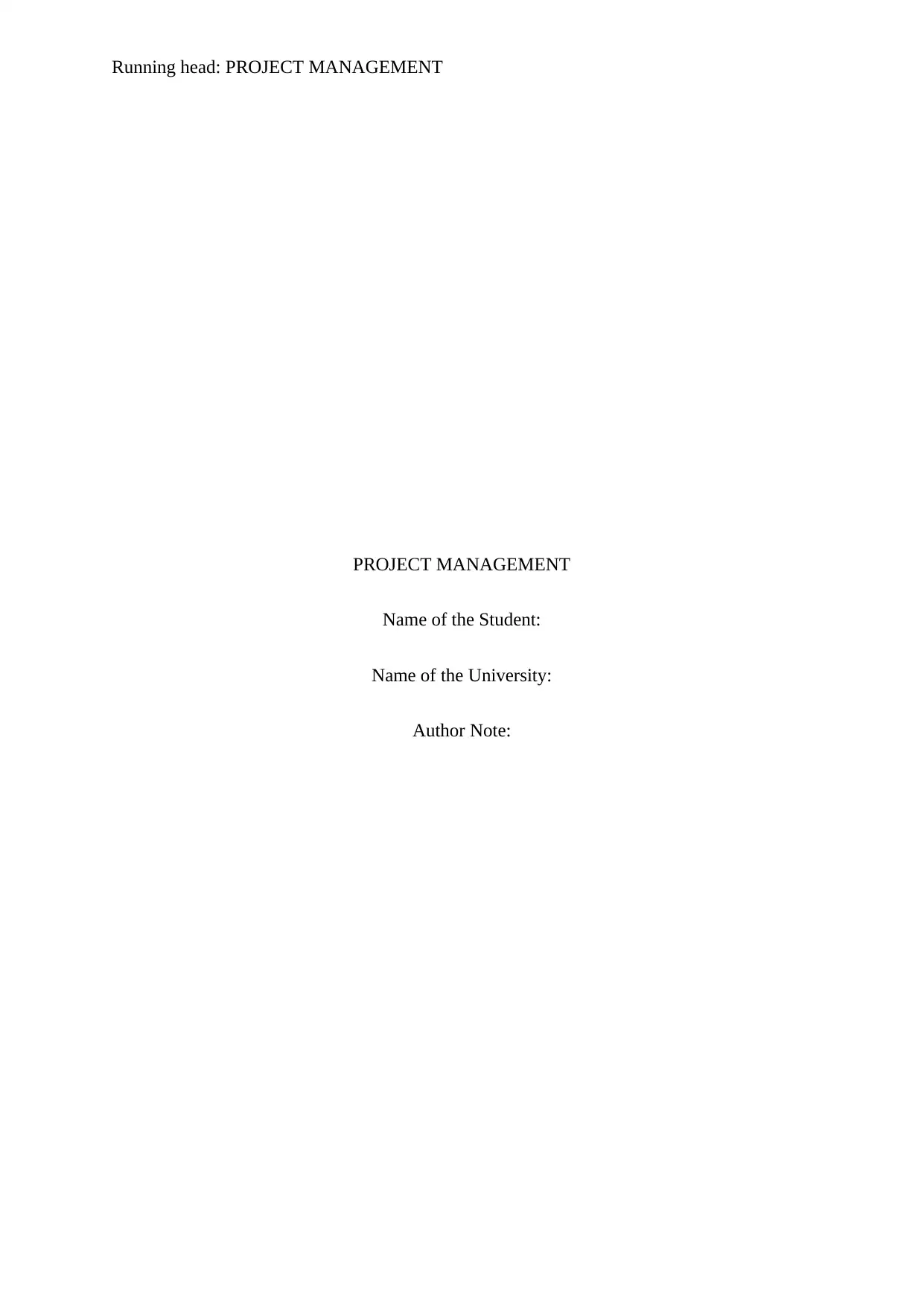
Running head: PROJECT MANAGEMENT
PROJECT MANAGEMENT
Name of the Student:
Name of the University:
Author Note:
PROJECT MANAGEMENT
Name of the Student:
Name of the University:
Author Note:
Paraphrase This Document
Need a fresh take? Get an instant paraphrase of this document with our AI Paraphraser
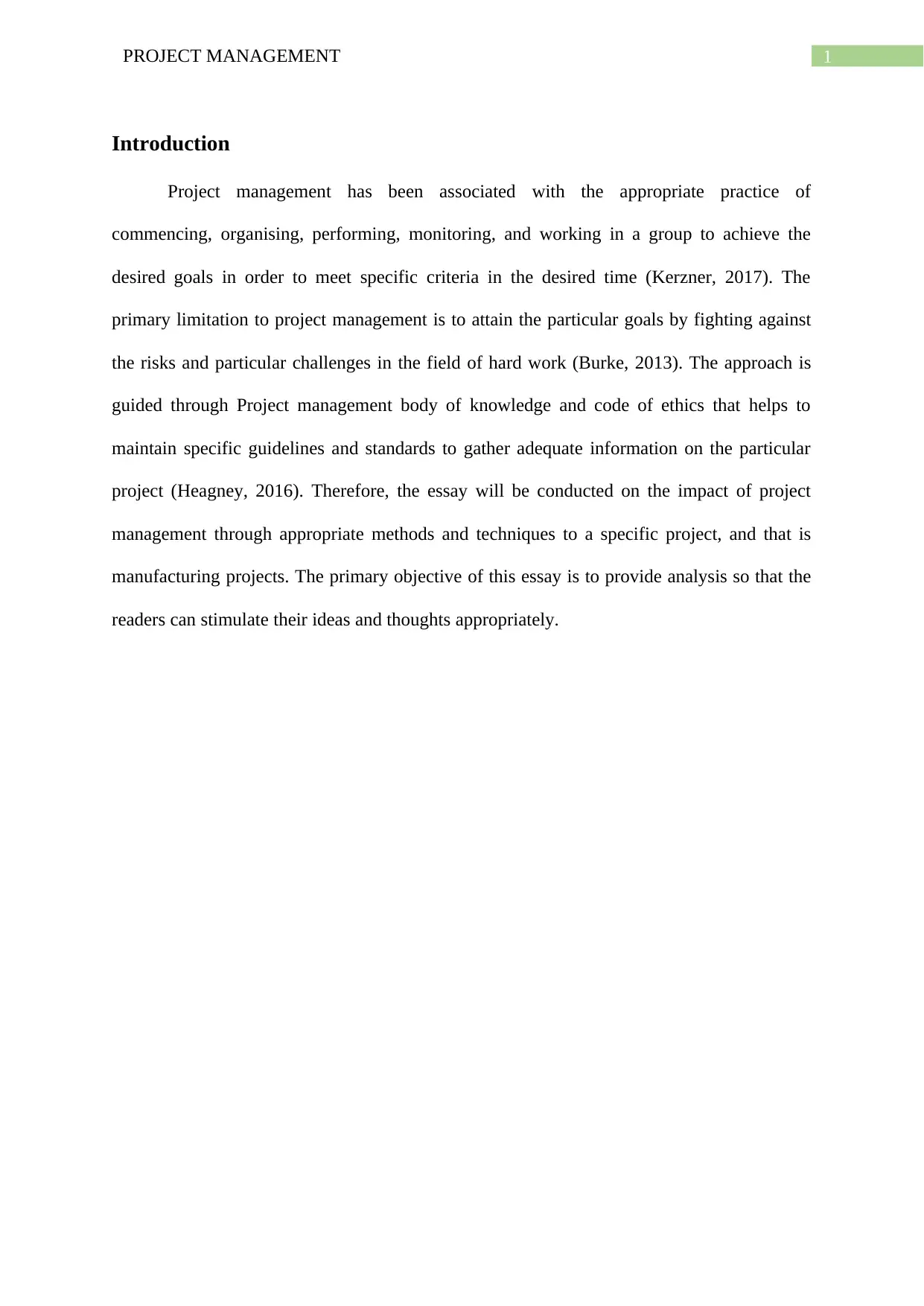
1PROJECT MANAGEMENT
Introduction
Project management has been associated with the appropriate practice of
commencing, organising, performing, monitoring, and working in a group to achieve the
desired goals in order to meet specific criteria in the desired time (Kerzner, 2017). The
primary limitation to project management is to attain the particular goals by fighting against
the risks and particular challenges in the field of hard work (Burke, 2013). The approach is
guided through Project management body of knowledge and code of ethics that helps to
maintain specific guidelines and standards to gather adequate information on the particular
project (Heagney, 2016). Therefore, the essay will be conducted on the impact of project
management through appropriate methods and techniques to a specific project, and that is
manufacturing projects. The primary objective of this essay is to provide analysis so that the
readers can stimulate their ideas and thoughts appropriately.
Introduction
Project management has been associated with the appropriate practice of
commencing, organising, performing, monitoring, and working in a group to achieve the
desired goals in order to meet specific criteria in the desired time (Kerzner, 2017). The
primary limitation to project management is to attain the particular goals by fighting against
the risks and particular challenges in the field of hard work (Burke, 2013). The approach is
guided through Project management body of knowledge and code of ethics that helps to
maintain specific guidelines and standards to gather adequate information on the particular
project (Heagney, 2016). Therefore, the essay will be conducted on the impact of project
management through appropriate methods and techniques to a specific project, and that is
manufacturing projects. The primary objective of this essay is to provide analysis so that the
readers can stimulate their ideas and thoughts appropriately.
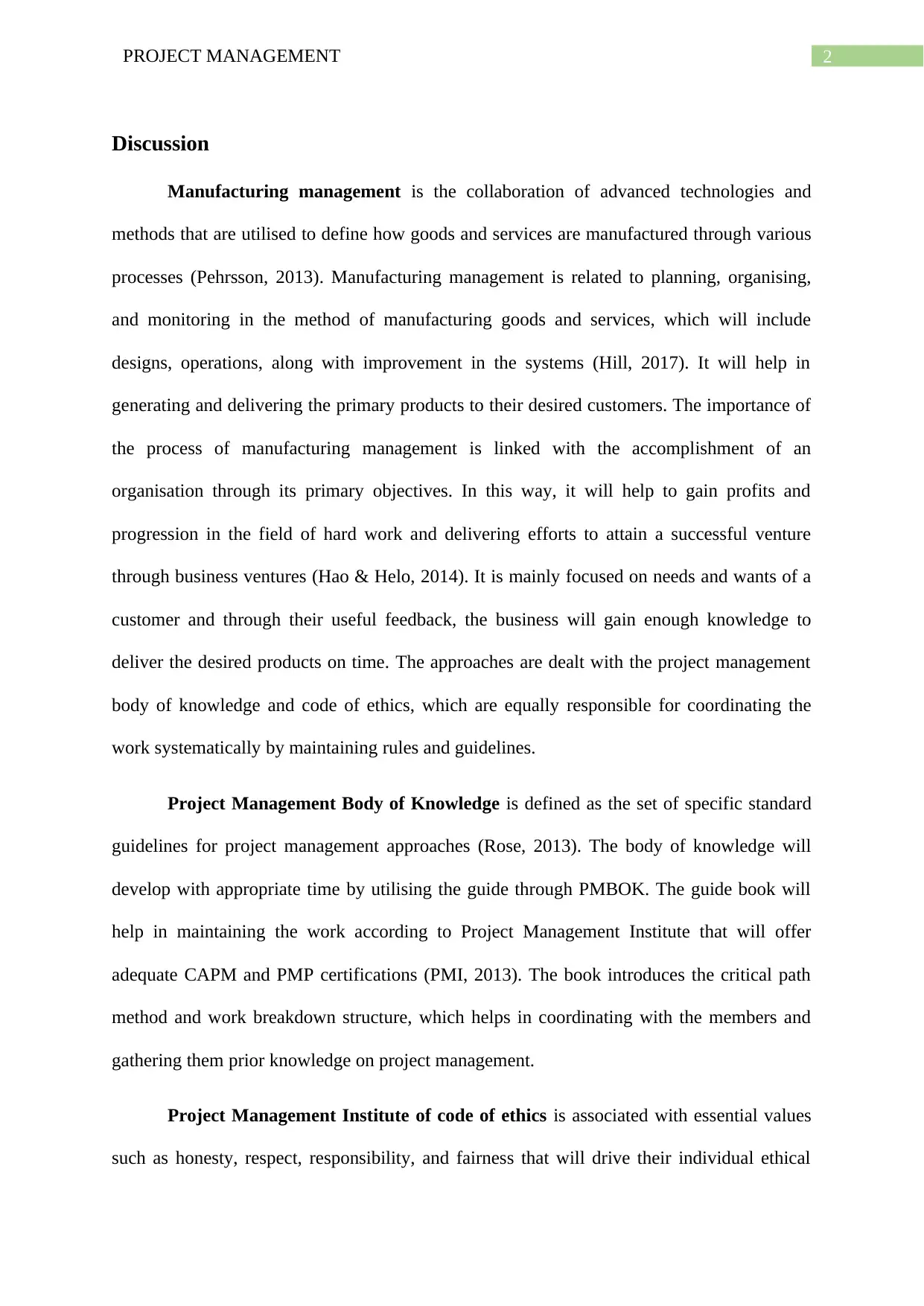
2PROJECT MANAGEMENT
Discussion
Manufacturing management is the collaboration of advanced technologies and
methods that are utilised to define how goods and services are manufactured through various
processes (Pehrsson, 2013). Manufacturing management is related to planning, organising,
and monitoring in the method of manufacturing goods and services, which will include
designs, operations, along with improvement in the systems (Hill, 2017). It will help in
generating and delivering the primary products to their desired customers. The importance of
the process of manufacturing management is linked with the accomplishment of an
organisation through its primary objectives. In this way, it will help to gain profits and
progression in the field of hard work and delivering efforts to attain a successful venture
through business ventures (Hao & Helo, 2014). It is mainly focused on needs and wants of a
customer and through their useful feedback, the business will gain enough knowledge to
deliver the desired products on time. The approaches are dealt with the project management
body of knowledge and code of ethics, which are equally responsible for coordinating the
work systematically by maintaining rules and guidelines.
Project Management Body of Knowledge is defined as the set of specific standard
guidelines for project management approaches (Rose, 2013). The body of knowledge will
develop with appropriate time by utilising the guide through PMBOK. The guide book will
help in maintaining the work according to Project Management Institute that will offer
adequate CAPM and PMP certifications (PMI, 2013). The book introduces the critical path
method and work breakdown structure, which helps in coordinating with the members and
gathering them prior knowledge on project management.
Project Management Institute of code of ethics is associated with essential values
such as honesty, respect, responsibility, and fairness that will drive their individual ethical
Discussion
Manufacturing management is the collaboration of advanced technologies and
methods that are utilised to define how goods and services are manufactured through various
processes (Pehrsson, 2013). Manufacturing management is related to planning, organising,
and monitoring in the method of manufacturing goods and services, which will include
designs, operations, along with improvement in the systems (Hill, 2017). It will help in
generating and delivering the primary products to their desired customers. The importance of
the process of manufacturing management is linked with the accomplishment of an
organisation through its primary objectives. In this way, it will help to gain profits and
progression in the field of hard work and delivering efforts to attain a successful venture
through business ventures (Hao & Helo, 2014). It is mainly focused on needs and wants of a
customer and through their useful feedback, the business will gain enough knowledge to
deliver the desired products on time. The approaches are dealt with the project management
body of knowledge and code of ethics, which are equally responsible for coordinating the
work systematically by maintaining rules and guidelines.
Project Management Body of Knowledge is defined as the set of specific standard
guidelines for project management approaches (Rose, 2013). The body of knowledge will
develop with appropriate time by utilising the guide through PMBOK. The guide book will
help in maintaining the work according to Project Management Institute that will offer
adequate CAPM and PMP certifications (PMI, 2013). The book introduces the critical path
method and work breakdown structure, which helps in coordinating with the members and
gathering them prior knowledge on project management.
Project Management Institute of code of ethics is associated with essential values
such as honesty, respect, responsibility, and fairness that will drive their individual ethical
⊘ This is a preview!⊘
Do you want full access?
Subscribe today to unlock all pages.

Trusted by 1+ million students worldwide
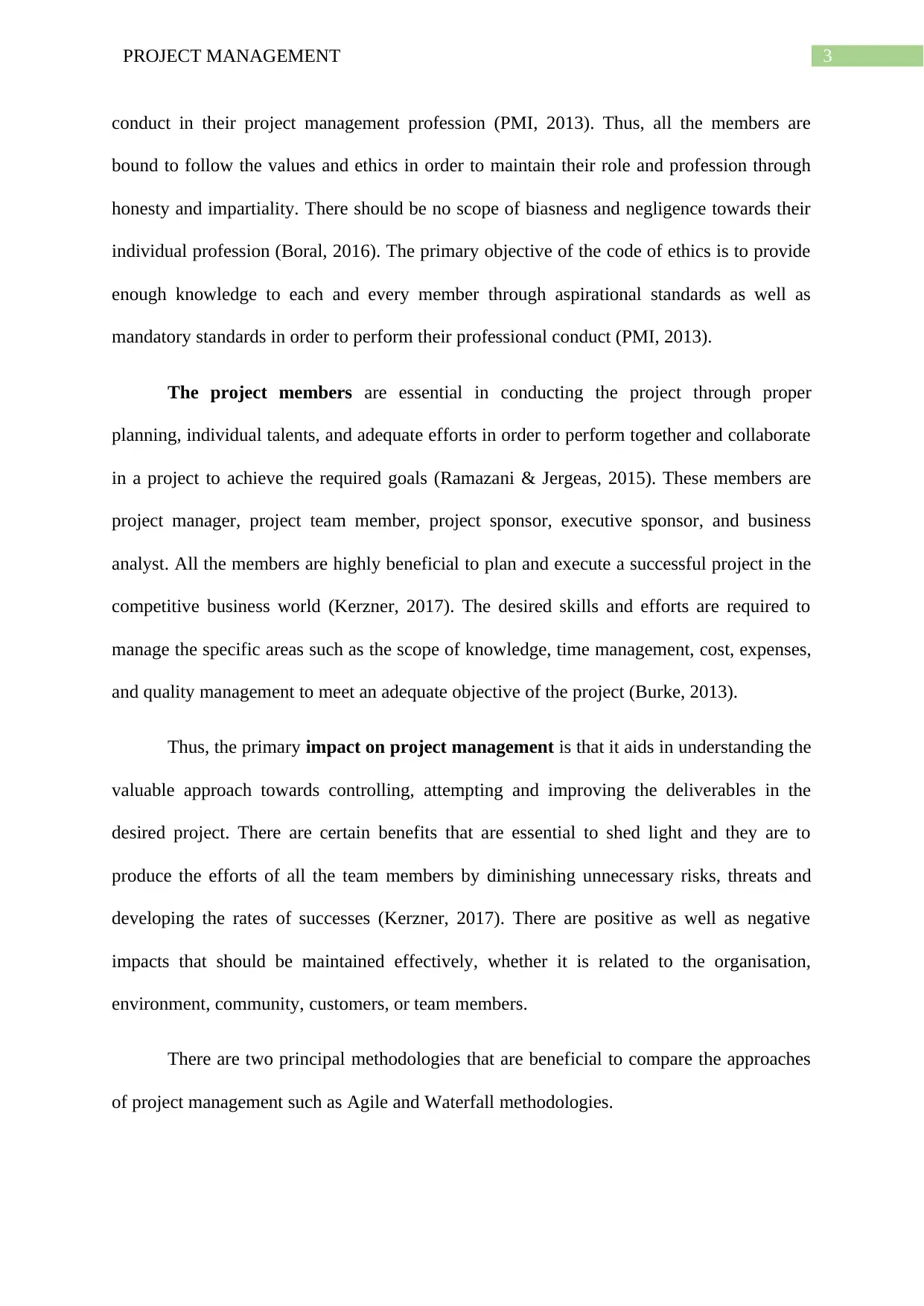
3PROJECT MANAGEMENT
conduct in their project management profession (PMI, 2013). Thus, all the members are
bound to follow the values and ethics in order to maintain their role and profession through
honesty and impartiality. There should be no scope of biasness and negligence towards their
individual profession (Boral, 2016). The primary objective of the code of ethics is to provide
enough knowledge to each and every member through aspirational standards as well as
mandatory standards in order to perform their professional conduct (PMI, 2013).
The project members are essential in conducting the project through proper
planning, individual talents, and adequate efforts in order to perform together and collaborate
in a project to achieve the required goals (Ramazani & Jergeas, 2015). These members are
project manager, project team member, project sponsor, executive sponsor, and business
analyst. All the members are highly beneficial to plan and execute a successful project in the
competitive business world (Kerzner, 2017). The desired skills and efforts are required to
manage the specific areas such as the scope of knowledge, time management, cost, expenses,
and quality management to meet an adequate objective of the project (Burke, 2013).
Thus, the primary impact on project management is that it aids in understanding the
valuable approach towards controlling, attempting and improving the deliverables in the
desired project. There are certain benefits that are essential to shed light and they are to
produce the efforts of all the team members by diminishing unnecessary risks, threats and
developing the rates of successes (Kerzner, 2017). There are positive as well as negative
impacts that should be maintained effectively, whether it is related to the organisation,
environment, community, customers, or team members.
There are two principal methodologies that are beneficial to compare the approaches
of project management such as Agile and Waterfall methodologies.
conduct in their project management profession (PMI, 2013). Thus, all the members are
bound to follow the values and ethics in order to maintain their role and profession through
honesty and impartiality. There should be no scope of biasness and negligence towards their
individual profession (Boral, 2016). The primary objective of the code of ethics is to provide
enough knowledge to each and every member through aspirational standards as well as
mandatory standards in order to perform their professional conduct (PMI, 2013).
The project members are essential in conducting the project through proper
planning, individual talents, and adequate efforts in order to perform together and collaborate
in a project to achieve the required goals (Ramazani & Jergeas, 2015). These members are
project manager, project team member, project sponsor, executive sponsor, and business
analyst. All the members are highly beneficial to plan and execute a successful project in the
competitive business world (Kerzner, 2017). The desired skills and efforts are required to
manage the specific areas such as the scope of knowledge, time management, cost, expenses,
and quality management to meet an adequate objective of the project (Burke, 2013).
Thus, the primary impact on project management is that it aids in understanding the
valuable approach towards controlling, attempting and improving the deliverables in the
desired project. There are certain benefits that are essential to shed light and they are to
produce the efforts of all the team members by diminishing unnecessary risks, threats and
developing the rates of successes (Kerzner, 2017). There are positive as well as negative
impacts that should be maintained effectively, whether it is related to the organisation,
environment, community, customers, or team members.
There are two principal methodologies that are beneficial to compare the approaches
of project management such as Agile and Waterfall methodologies.
Paraphrase This Document
Need a fresh take? Get an instant paraphrase of this document with our AI Paraphraser
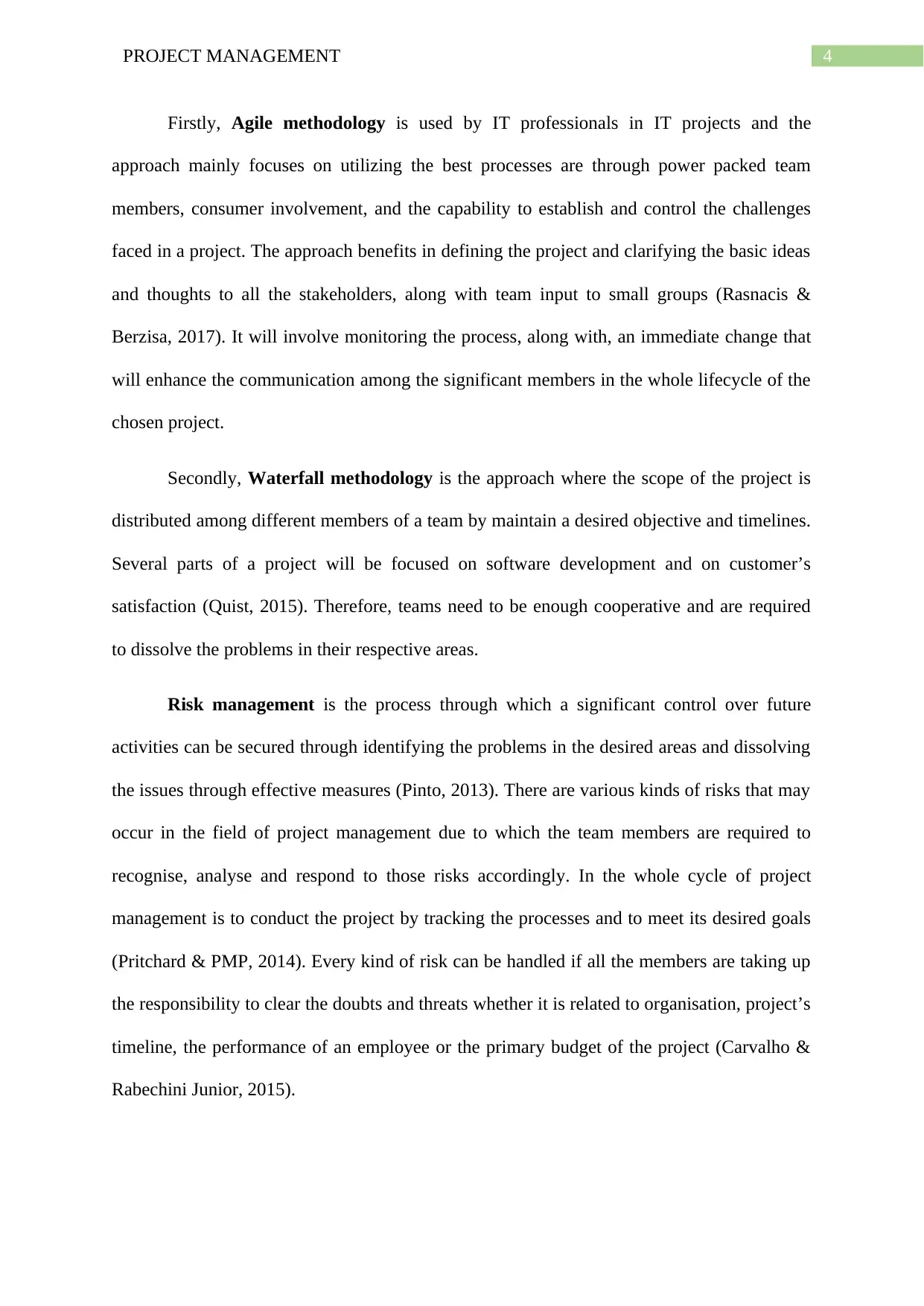
4PROJECT MANAGEMENT
Firstly, Agile methodology is used by IT professionals in IT projects and the
approach mainly focuses on utilizing the best processes are through power packed team
members, consumer involvement, and the capability to establish and control the challenges
faced in a project. The approach benefits in defining the project and clarifying the basic ideas
and thoughts to all the stakeholders, along with team input to small groups (Rasnacis &
Berzisa, 2017). It will involve monitoring the process, along with, an immediate change that
will enhance the communication among the significant members in the whole lifecycle of the
chosen project.
Secondly, Waterfall methodology is the approach where the scope of the project is
distributed among different members of a team by maintain a desired objective and timelines.
Several parts of a project will be focused on software development and on customer’s
satisfaction (Quist, 2015). Therefore, teams need to be enough cooperative and are required
to dissolve the problems in their respective areas.
Risk management is the process through which a significant control over future
activities can be secured through identifying the problems in the desired areas and dissolving
the issues through effective measures (Pinto, 2013). There are various kinds of risks that may
occur in the field of project management due to which the team members are required to
recognise, analyse and respond to those risks accordingly. In the whole cycle of project
management is to conduct the project by tracking the processes and to meet its desired goals
(Pritchard & PMP, 2014). Every kind of risk can be handled if all the members are taking up
the responsibility to clear the doubts and threats whether it is related to organisation, project’s
timeline, the performance of an employee or the primary budget of the project (Carvalho &
Rabechini Junior, 2015).
Firstly, Agile methodology is used by IT professionals in IT projects and the
approach mainly focuses on utilizing the best processes are through power packed team
members, consumer involvement, and the capability to establish and control the challenges
faced in a project. The approach benefits in defining the project and clarifying the basic ideas
and thoughts to all the stakeholders, along with team input to small groups (Rasnacis &
Berzisa, 2017). It will involve monitoring the process, along with, an immediate change that
will enhance the communication among the significant members in the whole lifecycle of the
chosen project.
Secondly, Waterfall methodology is the approach where the scope of the project is
distributed among different members of a team by maintain a desired objective and timelines.
Several parts of a project will be focused on software development and on customer’s
satisfaction (Quist, 2015). Therefore, teams need to be enough cooperative and are required
to dissolve the problems in their respective areas.
Risk management is the process through which a significant control over future
activities can be secured through identifying the problems in the desired areas and dissolving
the issues through effective measures (Pinto, 2013). There are various kinds of risks that may
occur in the field of project management due to which the team members are required to
recognise, analyse and respond to those risks accordingly. In the whole cycle of project
management is to conduct the project by tracking the processes and to meet its desired goals
(Pritchard & PMP, 2014). Every kind of risk can be handled if all the members are taking up
the responsibility to clear the doubts and threats whether it is related to organisation, project’s
timeline, the performance of an employee or the primary budget of the project (Carvalho &
Rabechini Junior, 2015).
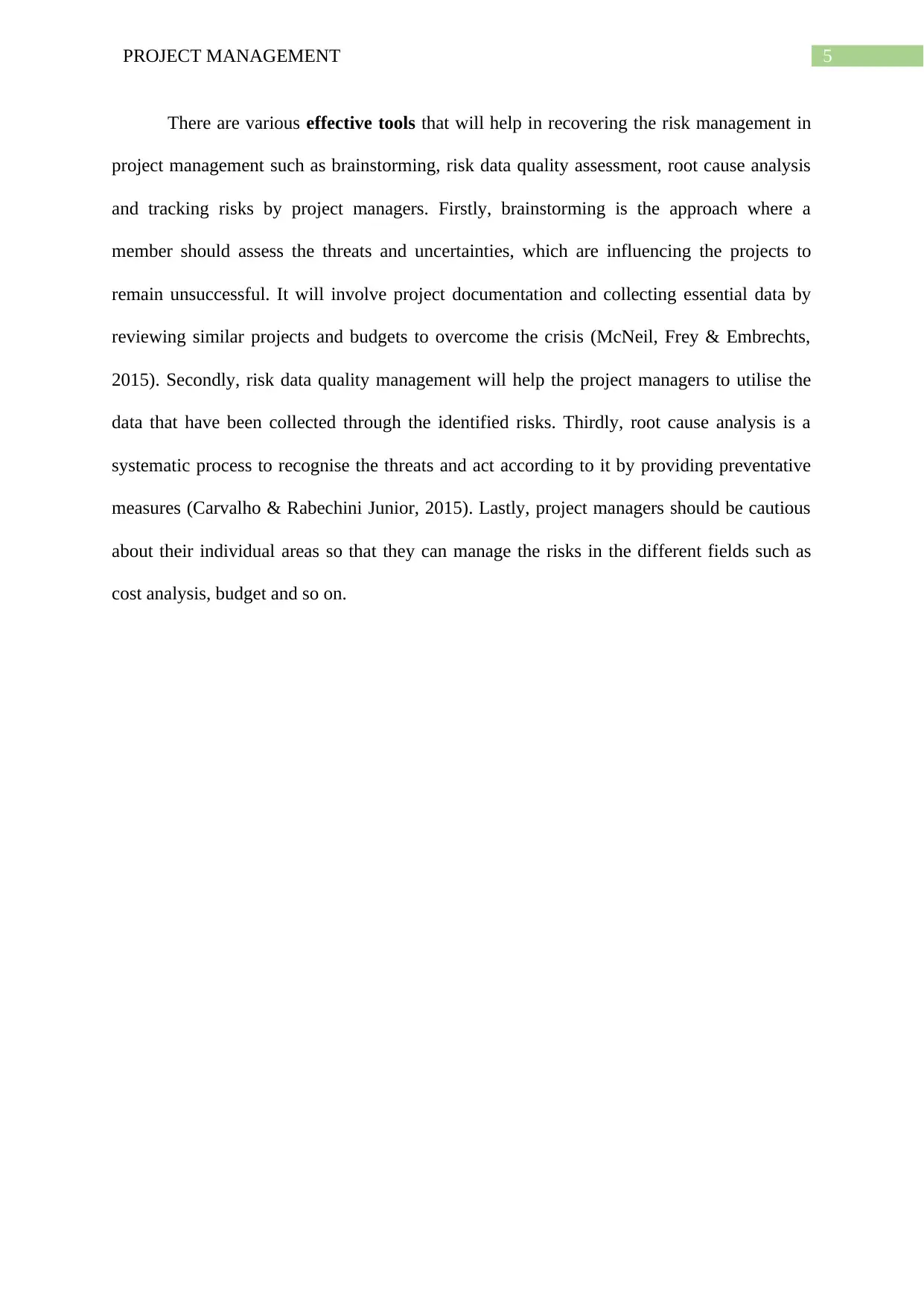
5PROJECT MANAGEMENT
There are various effective tools that will help in recovering the risk management in
project management such as brainstorming, risk data quality assessment, root cause analysis
and tracking risks by project managers. Firstly, brainstorming is the approach where a
member should assess the threats and uncertainties, which are influencing the projects to
remain unsuccessful. It will involve project documentation and collecting essential data by
reviewing similar projects and budgets to overcome the crisis (McNeil, Frey & Embrechts,
2015). Secondly, risk data quality management will help the project managers to utilise the
data that have been collected through the identified risks. Thirdly, root cause analysis is a
systematic process to recognise the threats and act according to it by providing preventative
measures (Carvalho & Rabechini Junior, 2015). Lastly, project managers should be cautious
about their individual areas so that they can manage the risks in the different fields such as
cost analysis, budget and so on.
There are various effective tools that will help in recovering the risk management in
project management such as brainstorming, risk data quality assessment, root cause analysis
and tracking risks by project managers. Firstly, brainstorming is the approach where a
member should assess the threats and uncertainties, which are influencing the projects to
remain unsuccessful. It will involve project documentation and collecting essential data by
reviewing similar projects and budgets to overcome the crisis (McNeil, Frey & Embrechts,
2015). Secondly, risk data quality management will help the project managers to utilise the
data that have been collected through the identified risks. Thirdly, root cause analysis is a
systematic process to recognise the threats and act according to it by providing preventative
measures (Carvalho & Rabechini Junior, 2015). Lastly, project managers should be cautious
about their individual areas so that they can manage the risks in the different fields such as
cost analysis, budget and so on.
⊘ This is a preview!⊘
Do you want full access?
Subscribe today to unlock all pages.

Trusted by 1+ million students worldwide
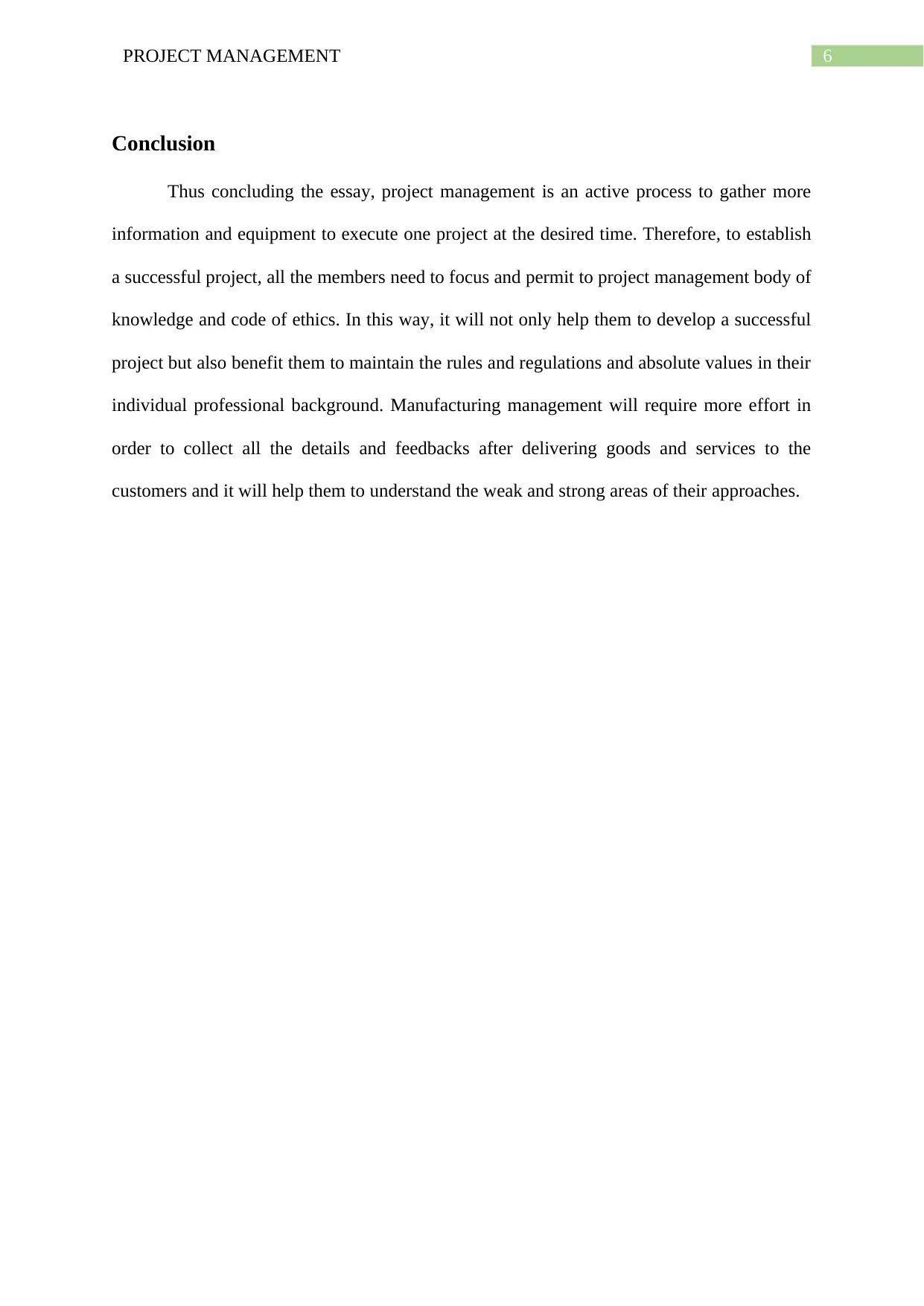
6PROJECT MANAGEMENT
Conclusion
Thus concluding the essay, project management is an active process to gather more
information and equipment to execute one project at the desired time. Therefore, to establish
a successful project, all the members need to focus and permit to project management body of
knowledge and code of ethics. In this way, it will not only help them to develop a successful
project but also benefit them to maintain the rules and regulations and absolute values in their
individual professional background. Manufacturing management will require more effort in
order to collect all the details and feedbacks after delivering goods and services to the
customers and it will help them to understand the weak and strong areas of their approaches.
Conclusion
Thus concluding the essay, project management is an active process to gather more
information and equipment to execute one project at the desired time. Therefore, to establish
a successful project, all the members need to focus and permit to project management body of
knowledge and code of ethics. In this way, it will not only help them to develop a successful
project but also benefit them to maintain the rules and regulations and absolute values in their
individual professional background. Manufacturing management will require more effort in
order to collect all the details and feedbacks after delivering goods and services to the
customers and it will help them to understand the weak and strong areas of their approaches.
Paraphrase This Document
Need a fresh take? Get an instant paraphrase of this document with our AI Paraphraser
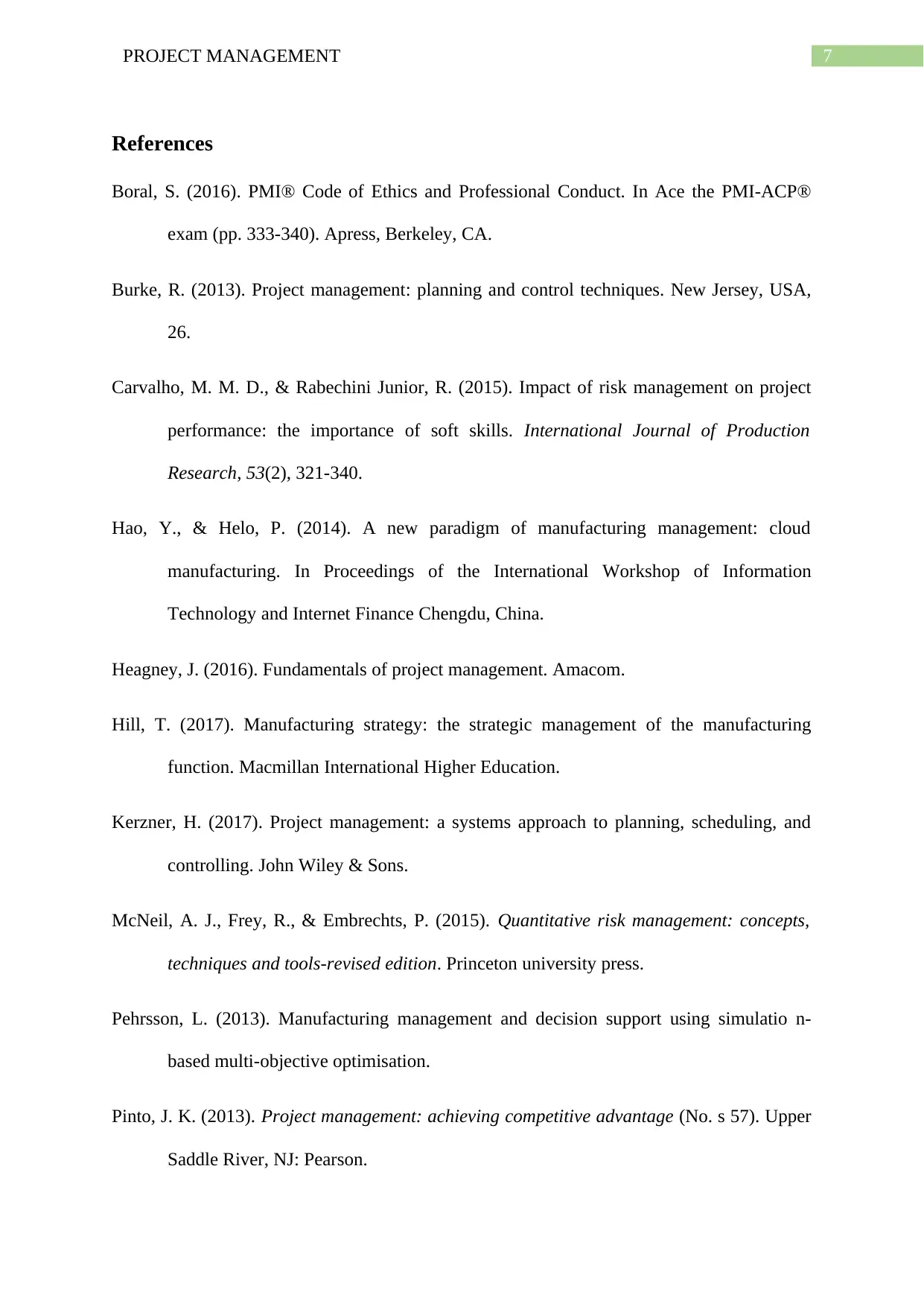
7PROJECT MANAGEMENT
References
Boral, S. (2016). PMI® Code of Ethics and Professional Conduct. In Ace the PMI-ACP®
exam (pp. 333-340). Apress, Berkeley, CA.
Burke, R. (2013). Project management: planning and control techniques. New Jersey, USA,
26.
Carvalho, M. M. D., & Rabechini Junior, R. (2015). Impact of risk management on project
performance: the importance of soft skills. International Journal of Production
Research, 53(2), 321-340.
Hao, Y., & Helo, P. (2014). A new paradigm of manufacturing management: cloud
manufacturing. In Proceedings of the International Workshop of Information
Technology and Internet Finance Chengdu, China.
Heagney, J. (2016). Fundamentals of project management. Amacom.
Hill, T. (2017). Manufacturing strategy: the strategic management of the manufacturing
function. Macmillan International Higher Education.
Kerzner, H. (2017). Project management: a systems approach to planning, scheduling, and
controlling. John Wiley & Sons.
McNeil, A. J., Frey, R., & Embrechts, P. (2015). Quantitative risk management: concepts,
techniques and tools-revised edition. Princeton university press.
Pehrsson, L. (2013). Manufacturing management and decision support using simulatio n-
based multi-objective optimisation.
Pinto, J. K. (2013). Project management: achieving competitive advantage (No. s 57). Upper
Saddle River, NJ: Pearson.
References
Boral, S. (2016). PMI® Code of Ethics and Professional Conduct. In Ace the PMI-ACP®
exam (pp. 333-340). Apress, Berkeley, CA.
Burke, R. (2013). Project management: planning and control techniques. New Jersey, USA,
26.
Carvalho, M. M. D., & Rabechini Junior, R. (2015). Impact of risk management on project
performance: the importance of soft skills. International Journal of Production
Research, 53(2), 321-340.
Hao, Y., & Helo, P. (2014). A new paradigm of manufacturing management: cloud
manufacturing. In Proceedings of the International Workshop of Information
Technology and Internet Finance Chengdu, China.
Heagney, J. (2016). Fundamentals of project management. Amacom.
Hill, T. (2017). Manufacturing strategy: the strategic management of the manufacturing
function. Macmillan International Higher Education.
Kerzner, H. (2017). Project management: a systems approach to planning, scheduling, and
controlling. John Wiley & Sons.
McNeil, A. J., Frey, R., & Embrechts, P. (2015). Quantitative risk management: concepts,
techniques and tools-revised edition. Princeton university press.
Pehrsson, L. (2013). Manufacturing management and decision support using simulatio n-
based multi-objective optimisation.
Pinto, J. K. (2013). Project management: achieving competitive advantage (No. s 57). Upper
Saddle River, NJ: Pearson.
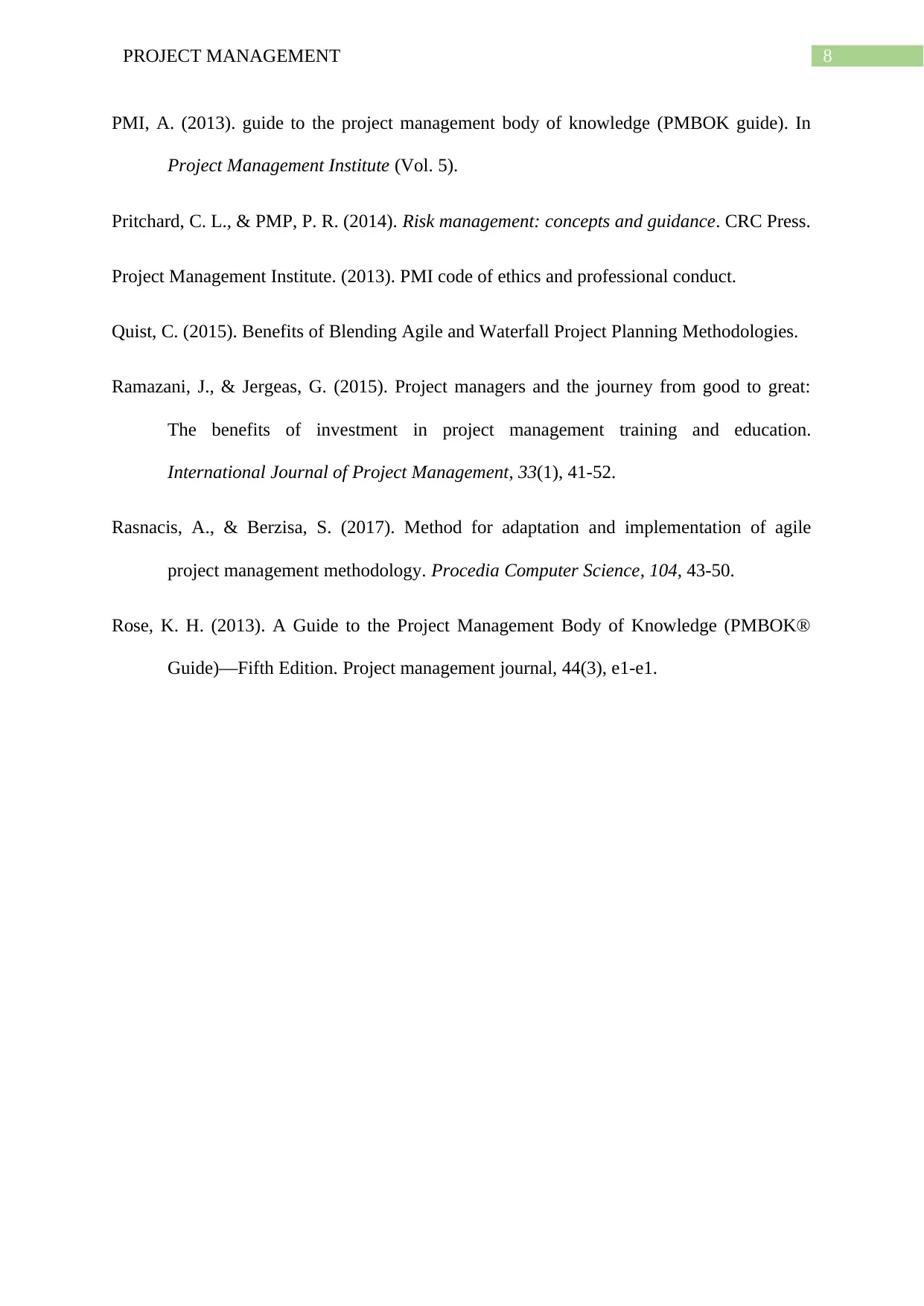
8PROJECT MANAGEMENT
PMI, A. (2013). guide to the project management body of knowledge (PMBOK guide). In
Project Management Institute (Vol. 5).
Pritchard, C. L., & PMP, P. R. (2014). Risk management: concepts and guidance. CRC Press.
Project Management Institute. (2013). PMI code of ethics and professional conduct.
Quist, C. (2015). Benefits of Blending Agile and Waterfall Project Planning Methodologies.
Ramazani, J., & Jergeas, G. (2015). Project managers and the journey from good to great:
The benefits of investment in project management training and education.
International Journal of Project Management, 33(1), 41-52.
Rasnacis, A., & Berzisa, S. (2017). Method for adaptation and implementation of agile
project management methodology. Procedia Computer Science, 104, 43-50.
Rose, K. H. (2013). A Guide to the Project Management Body of Knowledge (PMBOK®
Guide)—Fifth Edition. Project management journal, 44(3), e1-e1.
PMI, A. (2013). guide to the project management body of knowledge (PMBOK guide). In
Project Management Institute (Vol. 5).
Pritchard, C. L., & PMP, P. R. (2014). Risk management: concepts and guidance. CRC Press.
Project Management Institute. (2013). PMI code of ethics and professional conduct.
Quist, C. (2015). Benefits of Blending Agile and Waterfall Project Planning Methodologies.
Ramazani, J., & Jergeas, G. (2015). Project managers and the journey from good to great:
The benefits of investment in project management training and education.
International Journal of Project Management, 33(1), 41-52.
Rasnacis, A., & Berzisa, S. (2017). Method for adaptation and implementation of agile
project management methodology. Procedia Computer Science, 104, 43-50.
Rose, K. H. (2013). A Guide to the Project Management Body of Knowledge (PMBOK®
Guide)—Fifth Edition. Project management journal, 44(3), e1-e1.
⊘ This is a preview!⊘
Do you want full access?
Subscribe today to unlock all pages.

Trusted by 1+ million students worldwide
1 out of 9
Related Documents
Your All-in-One AI-Powered Toolkit for Academic Success.
+13062052269
info@desklib.com
Available 24*7 on WhatsApp / Email
![[object Object]](/_next/static/media/star-bottom.7253800d.svg)
Unlock your academic potential
Copyright © 2020–2025 A2Z Services. All Rights Reserved. Developed and managed by ZUCOL.





